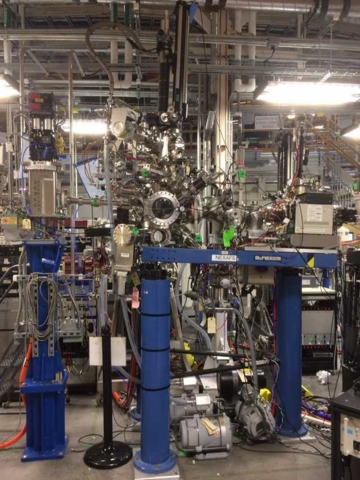Near Edge X-ray Absorption Fine Structure (NEXAFS)

View of the Near Edge X-ray Fine Structure (NEXAFS) experimental station operated by the NIST Synchrotron Science Group at the National Synchrotron Light Source II.
The Near Edge X-ray Absorption Fine Structure (NEXAFS) experimental stations uses a tunable, focused monochromatic beam of soft X-rays (0.1 keV to 2.2 keV) to excite core electrons of elements. The excitation process results in the emission of photoelectrons and photons (fluorescence) that are detected, revealing details of the chemical, electronic, and molecular structure of materials within the first 10 nm of the surface (depth selective). With a concentric hemispherical analyzer and channeltron electron multipliers, NEXAFS can operate in partial and total electron yield modes, as well as fluorescence yield mode, with a minimum beam size of 35 µm.The NEXAFS end station is located on the Spectroscopy Soft and Tender (SST-I) beamline, one of three beamlines built, designed, and operated by NIST in partnership with Brookhaven National Laboratory at the National Synchrotron Light Source (NSLS-II).
Emission at incident energies just above the excitation energy, or absorption edge, of an element provide information on elemental concentrations. In addition to the original photoelectron measured by X-ray Photoelectron Spectroscopy (XPS), NEXAFS measures with high energy resolution fluorescent photons, Auger electrons, and inelastically scattered photoelectrons produced as the core hole is filled. In contrast to the original photoelectron, these secondary products reflect electrons in bonded orbitals, providing key data on elemental and molecular bonding. Building off of this concept, the polarized beam afforded by SST-I provides additional insight into molecular orientation. Importantly, the disparity in mean free path of photons and electrons provides a route to compare these quantities at the surface and in the bulk of a sample in the same experiment. The NEXAFS spectrometer is designed to collect spectra at high speeds, with automated data acquisition and multi-sample stages, enabling the routine measurement of 200+ spectra per day.
Specifications/Capabilities
Energy Range: 0.1 keV to 2.2 keV
Insertion Device: Elliptical Polarized Undulator (EPU)
Spot Size: 50 μm
Modes of Measurement: Partial and Total Electron Yield, Fluorescence Yield
Detection System: Concentric hemispherical analyzer, channeltron detector
Data Analysis: Data viewable by XDAC and analysis through the ATHENA package
Usage Information
Operating Schedule
NEXAFS is currently in commissioning, and is anticipated to be available for general users in 2019.
Access Information
All users are encouraged to discuss potential experiments with the relevant instrument scientist prior to applying for access. After commissioning is complete, access to NEXAFS will be granted based on merit of the proposed experiment through one of two mechanisms:
1) General users may apply for time through the general user program at NSLS-II. Qualifications, proposal templates, and guidelines are available at https://www.bnl.gov/ps/userguide/.
2) For NIST staff only: NIST projects may request access for experiments by contacting the instrument scientists listed here. Requests are collected and reviewed by the NIST BNL allocation committee and granted time based on merit and fit to the NIST mission. For more information, contact an instrument scientist listed here.

